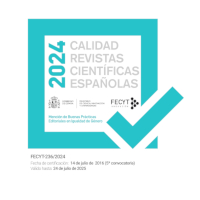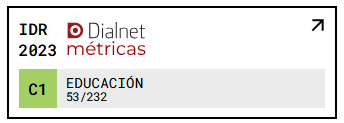Programa interdisciplinar que atiende a la educación para el ocio, el consumo y el medio ambiente basado en la producción de materiales didácticos y lúdicos de educación física
DOI:
https://doi.org/10.18172/con.412Abstract
We explain the contents of an educative programme that we evaluate with some strategies of action-research. This is a checked resource that can be used in Formal Education as well as in informal one. It seeks to develop positive attitudes towards the environment, the responsible consumer, the cooperation or the positive occupation of free time. All this is explained from an interdisciplinary perspective that turns round the material resources= building of physical education starting from waste products.Downloads
References
ALVIRA MARTÍN, F. (1991). Metodología de la evaluación de programas. Madrid: CIS
ARCA,J., DELPUY, E., LLANAS, T. y ROY, Y. (1997). Viaje al interior del cuerpo humano: una colonia para el tiempo libre. Madrid: CCS.
BARRENECHEA, P., LARRUGA, S. y VAREA, M. (1997). Basureros y vertederos de Aragón. Zaragoza: Mira editores.
BRAVO BERROCAL, R. y ROMERO RAMOS, O (1998). Actividades educativo-complementarias en la naturaleza. Granada: Aljibe.
CAMPBELL, D. T (1982). Grados de libertad y el estudio de casos, en Cook, T. D. y Reichardt, Ch. S. (1986) Métodos cualitativos y cuantitativos en investigación evaluativa. Madrid: Morata.
DE LA ORDEN, A. (1985) Investigación evaluativa, en de la Orden, A. (dir.) Investigación Educativa. Diccionario de Cas. Educación (pp. 133-137). Madrid: Anaya.
FILSTEAD, W. J. (1982). Métodos cualitativos. Una experiencia necesaria en la investigación evaluativa, en Cook, T. D. y Reichardt, Ch. S. (1986) Métodos cualitativos y cuantitativos en investigación evaluativa. Madrid: Morata.
GONZÁLEZ FARACO, J. C. (1997). Verde que te quiero verde...Un análisis crítico de los modelos hegemónicos en la Educación Ambiental, en Bordón 4(4), 435-444.
GONZÁLEZ LUCINI, F. (1994). Educación, ética y transversalidad, en Cuadernos de Pedagogía, 227, 10-13.
GUTIÉRREZ PÉREZ, J. (1995). La Educación Ambiental. Fundamentos teóricos, propuestas de transversalidad y orientaciones extracurriculares. Madrid: La Muralla.
MOPMA (1995). Medio ambiente en España. Madrid.
PONCE DE LEÓN ELIZONDO, A. (1998). Tiempo libre y rendimiento académico. Logroño: Universidad de La Rioja
PONCE DE LEÓN ELIZONDO, A. (1997). “Reflexiones y conclusiones sobre el tiempo libre y los valores”, Bordón, 49, 87-94.
PONCE DE LEÓN ELIZONDO, A. y GARGALLO IBORT, E. (Coords.) (1999a). Reciclo, construyo, juego y me divierto. Una propuesta interdisciplinar para la Educación del Ocio, el Consumo, el Medio Ambiente y la Educación Física. Madrid: CCS.
PONCE DE LEÓN ELIZONDO, A., GARGALLO IBORT, E., LEMUS VARELA, M. C., LOZA OLAVE, E., FERNÁNDEZ ARMESTO, M. L., TREVIÑO FERNÁNDEZ, M. P. y PASCUAL SUFRATE, M. T. (1999 b). Experiencia interdisciplinar: innovación en la escuela y en la formación inicial del profesorado, en Revista Interuniversitaria de Formación del Profesorado (En prensa).
RUTMAN, L. (1984). Introduction, en Rutman, L. (Ed.) Evaluation research methods: a base quide. London: Sage.
TONUCCI, F. (1988). A los tres años se investiga. Barcelona: Hogar del libro.
UNESCO Programa Internacional de Educación Ambiental (1994). Actividades de Educación Ambiental para la enseñanza Primaria. Ed. Los libros de la Catarata. Gobierno de La Rioja.
VELÁZQUEZ CALLADO, C. (1996). Actividades prácticas en Educación Física. Cómo utilizar materiales de desecho. Madrid: Escuela Española.
VV.AA. (1994). La respuesta curricular, Cuadernos de Pedagogía 227, 14-18.
YUS, R. (1996). Temas transversales. Hacia una nueva escuela. Barcelona: Grao.
YUS, R. (1996). Hacia una educación global desde la transversalidad. Madrid: Anaya Alauda.
Downloads
Published
How to Cite
Issue
Section
License
The authors retain copyright of articles and authorize Contextos Educativos. Revista de Educación the first publication. They are free to share and redistribute the article without obtaining permission from the publisher as long as they give appropriate credit to the editor and the journal.
Self-archiving is allowed too. In fact, it is recommendable to deposit a PDF version of the paper in academic and/or institutional repositories.












